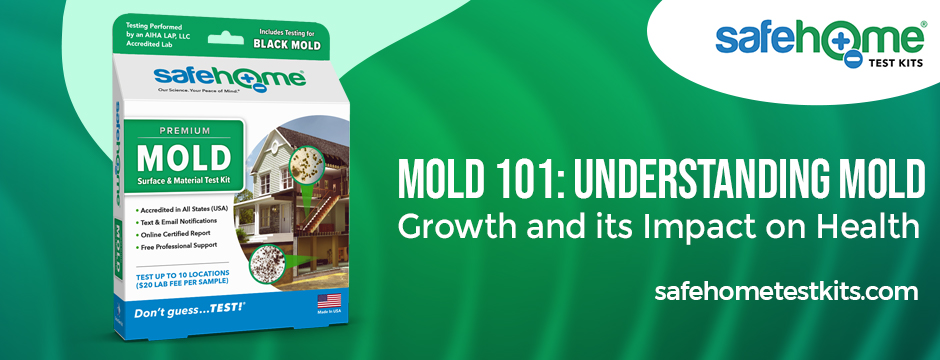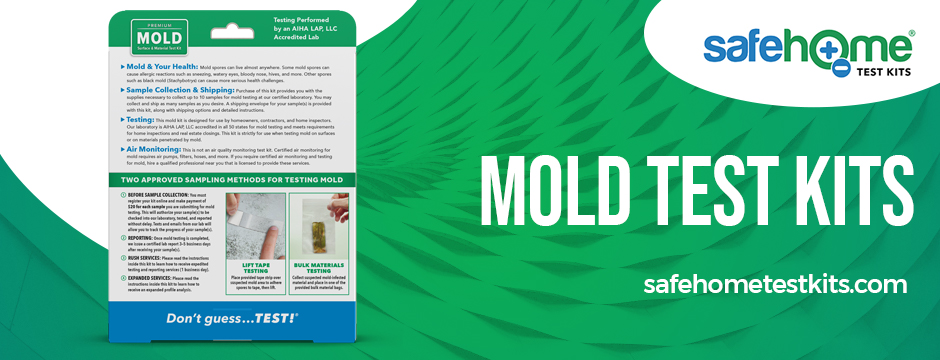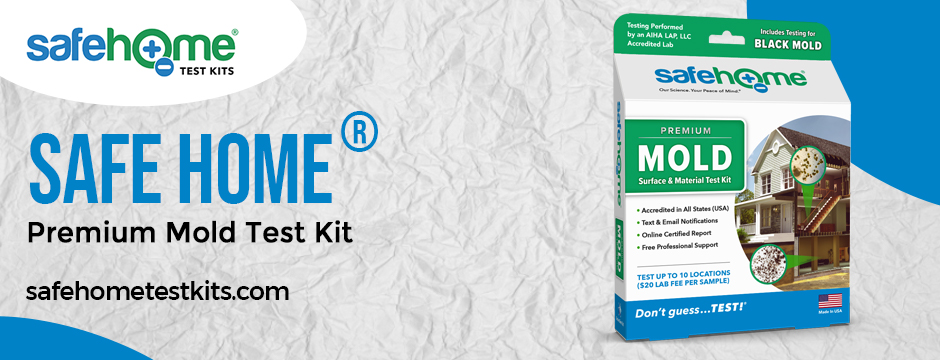Mold 101: Understanding Mold Growth and its Impact on Health

Mold is a common household nuisance that can significantly affect your health and your home’s structural integrity. Understanding mold growth and its health effects is crucial for maintaining a safe and comfortable living environment. In this comprehensive guide, we will delve into the various facets of mold, from its growth conditions to its potential health risks, detection, prevention, safe removal techniques, and how Safe Home®, with its mold test kit, can be your trump card.
Understanding Mold Growth
Mold thrives where moisture, organic materials, and poor ventilation intersect. These conditions create an ideal breeding ground for mold spores to take root and flourish. High moisture levels, often resulting from leaks, condensation, or high humidity, are conducive to mold growth. Organic materials such as wood, paper, and fabrics provide mold with the sustenance it needs to thrive. Poor ventilation and inadequate air circulation compound the issue by trapping excess moisture in confined spaces.
Common indoor areas prone to mold growth include bathrooms and kitchens due to the abundance of moisture generated from daily activities. Basements and crawlspaces, which are naturally damp and poorly ventilated, are prime breeding grounds. Attics and wall cavities may also harbor mold growth if moisture enters these spaces.
Types of Mold
Mold comes in various species with distinct characteristics and potential health implications. Some common types include:
- Stachybotrys chartarum (black mold): Known for its dark, slimy appearance, it is notorious for producing mycotoxins that can lead to severe health issues.
- Aspergillus: Found indoors and outdoors, Aspergillus can trigger allergic reactions and exacerbate respiratory problems.
- Penicillium: Often found on water-damaged materials, Penicillium can release allergens and mycotoxins, affecting both health and indoor air quality.
- Alternaria: Commonly found in damp spaces, Alternaria can cause allergies and worsen asthma symptoms.
Visual identification of mold involves recognizing colors like green, black, white, or brown and textures like fuzzy, slimy, or powdery. Growth patterns can vary, appearing as patches, clusters, or spreading across surfaces.
Health Effects of Mold Exposure
Respiratory Issues:
- Allergies and Allergic Reactions: Mold spores can trigger allergic reactions such as sneezing, coughing, and runny noses.
- Asthma Exacerbation: Individuals with asthma may experience worsened symptoms due to mold exposure.
Irritation of Skin, Eyes, and Mucous Membranes: Contact with mold or its spores can cause skin rashes, red eyes, and respiratory tract irritation.
More Severe Health Effects:
- Immunocompromised Individuals: People with weakened immune systems are at greater risk of severe respiratory infections from mold exposure.
- Mycotoxins and Their Potential Impact: Some molds produce mycotoxins that can lead to more severe health problems if ingested or inhaled.
Detecting Mold Infestations
Mold infestations can often remain hidden until they become a severe issue. Detecting mold early is crucial for preventing its growth and potential health risks.
Visual Signs of Mold Growth
- Discoloration and Staining: Keep an eye out for any unusual patches of discoloration on walls, ceilings, or even fabrics. These areas appear darker or have different shades than the surrounding surfaces. Stains can range from green and black to white or even orange.
- Musty Odor: A distinct musty smell can indicate the presence of mold, even if it’s not visible. This smell results from the compounds produced by mold as it feeds on organic materials. If you notice an earthy or damp odor, it’s time to investigate further.
Importance of Mold Testing and Professional Assessment
DIY Testing Kits vs. Professional Inspection:
While visual signs and odors can give you an idea of mold presence, they must provide a complete picture. DIY mold test kits can be helpful for initial insights, but they may not be as accurate as professional assessments.

Professional mold inspectors have the experience and tools to assess the extent of mold growth thoroughly, identify the types of mold present, and recommend appropriate remediation steps.
Understanding Mold Spore Levels and Significance:
Mold testing measures the concentration of mold spores in the air. While it’s normal to have some mold spores indoors, elevated levels can indicate a problem. However, the mere presence of mold spores doesn’t necessarily mean an active infestation.
Interpreting mold spore levels requires expertise. High levels of certain mold spores can be a cause for concern, primarily if they are known to be allergenic or toxic. Professional mold inspectors can help you understand the significance of these levels concerning your health and the health of your home.
Preventing Mold Growth
- Proper Ventilation: Adequate airflow is essential for keeping moisture levels in check. Ensure your home has good ventilation in bathrooms, kitchens, and basements. Consider using exhaust fans to reduce humidity after activities like cooking and showering.
- Dehumidifiers: Using a dehumidifier in areas with high humidity can help maintain optimal moisture levels. These devices extract excess moisture from the air, making it harder for mold to thrive.
Controlling Moisture and Humidity
Prevention is the key to avoiding mold-related issues. By taking proactive measures after detecting mold with a mold test kit, you can create an environment less conducive to mold growth.
Regular Maintenance and Upkeep
- Promptly Addressing Leaks and Water Damage: Water intrusion can quickly lead to mold growth. Repair leaks and address water damage immediately. Even minor leaks can provide enough moisture for mold to flourish.
- Proper Sealing and Insulation: Ensuring your home is well-sealed and insulated can prevent moisture from entering. Pay attention to areas like windows, doors, roofs, and pipes. Proper insulation also helps regulate temperature and humidity levels.
Steps for Safe Mold Removal
- Personal Protective Equipment (PPE): Wear masks, gloves, and goggles to minimize exposure.
- Containment of Affected Areas: Seal off the area to prevent mold spores from spreading.
- DIY Approach: Small, isolated infestations can be managed with proper precautions and by using a home test kit for mold.
- Professional Remediation: Extensive or toxic mold growth requires expert intervention.
- Cleaning and Disinfecting: Thoroughly clean and disinfect affected surfaces.
- Removing Affected Materials If Necessary: Irreparably damaged materials should be safely removed.
Hiring Professionals for Mold Remediation
When dealing with a significant mold problem, seeking the assistance of certified and experienced mold remediation experts is crucial. They have the knowledge and tools necessary to handle mold safely and effectively.
Importance of Certified and Experienced Mold Remediation Experts
- Expertise and Knowledge: Professionals understand the intricacies of mold growth, its different types, and the most effective removal methods. Their experience enables them to identify hidden mold, assess its extent, and develop a targeted remediation plan.
- Proper Equipment: Mold remediation requires specialized equipment, such as high-efficiency particulate air (HEPA) filters, negative air machines, and protective gear. Professionals have access to these tools, ensuring thorough removal without spreading spores.
- Safe Removal Practices: Improper handling of mold can lead to the dispersal of spores and exacerbate the problem. Certified experts follow industry standards to contain and remove mold safely, minimizing health risks.
Choosing the Right Professional Service
- Qualifications and Certifications: When selecting a mold remediation service, ensure they hold relevant certifications. Look for certificates from organizations such as the Institute of Inspection, Cleaning, and Restoration Certification (IICRC) or the National Association of Mold Professionals (NAMP). These certifications demonstrate the company’s commitment to adhering to industry best practices.
- Reputation and Reviews: Research the reputation of mold remediation companies in your area. Online reviews and testimonials can provide insights into their past client’s experiences. A reputable company will have positive feedback and a successful mold removal track record.
Post-Remediation Prevention
After mold remediation, it’s crucial to prevent its recurrence.
Maintenance Tips to Prevent Mold Recurrence
- Regular Inspections: Conduct routine home inspections, especially in moisture-prone areas. Check for any signs of water leaks, condensation, or discoloration that could indicate new mold growth.
- Proper Ventilation and Air Circulation: Ensure that your home is well-ventilated. Use exhaust fans in bathrooms and kitchens to expel excess moisture. Open windows and doors periodically to improve air circulation.
Monitoring Indoor Humidity Levels
- Ideal Range for Humidity: Maintain 30% and 50% indoor humidity levels. This range is inhospitable to mold growth. Use a hygrometer to measure humidity levels in different areas of your home.
- Humidity Monitoring Tools: Invest in humidity monitoring tools like digital hygrometers. These devices provide real-time information about humidity levels, helping you take prompt action if humidity rises beyond the recommended range.

Safe Home® - Premium Mold Test Kit: Detect Mold with Confidence
We are introducing the Safe Home® Premium Mold Test Kit – an all-inclusive solution for mold detection. Crafted to cater to homeowners, contractors, and home inspectors alike, this kit provides a seamless experience from start to finish. Effortlessly collect samples, and expect precise testing outcomes from an accredited laboratory. Our laboratory boasts AIHA LAP, LLC accreditation across all 50 states, validating our commitment to mold testing excellence. This accreditation aligns with the stringent requisites for many applications, encompassing home inspections, mortgage approvals, and real estate transactions. Equipped with the Premium Mold Test Kit, you can confidently pinpoint and tackle mold-related concerns, fostering a healthier and safer living environment for you and your cherished family. Without further ado, buy a mold test kit today at Safe Home®!
Final Thoughts
Understanding mold growth and its potential health effects is crucial for maintaining a safe and comfortable home. You can create a living space that promotes well-being by following preventive measures, recognizing the signs of mold infestations, and seeking professional assistance when necessary. With resources like the Safe Home® Premium Mold Test Kit, you can take proactive steps to tackle mold issues and ensure a healthy living environment for years.


